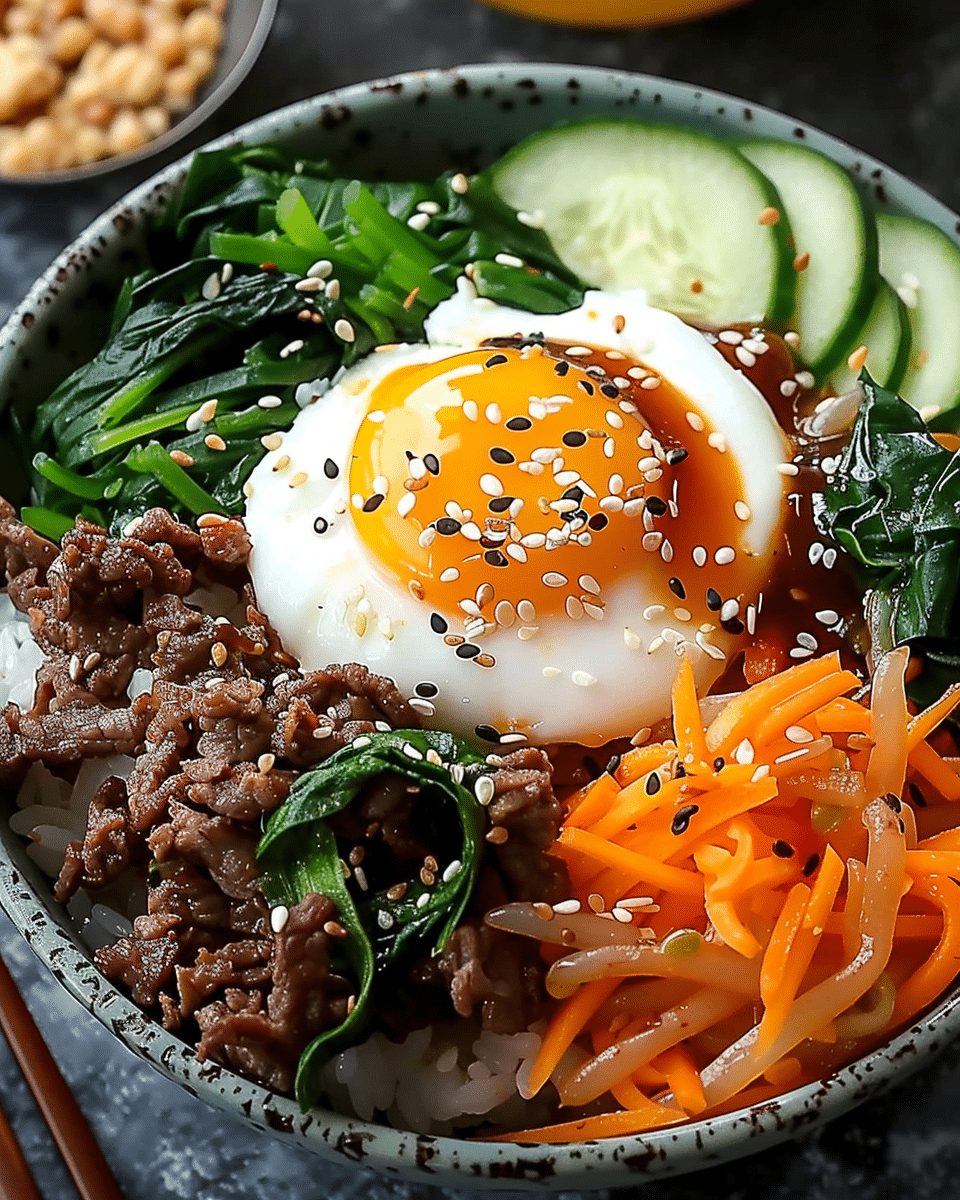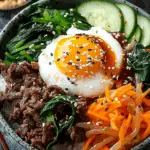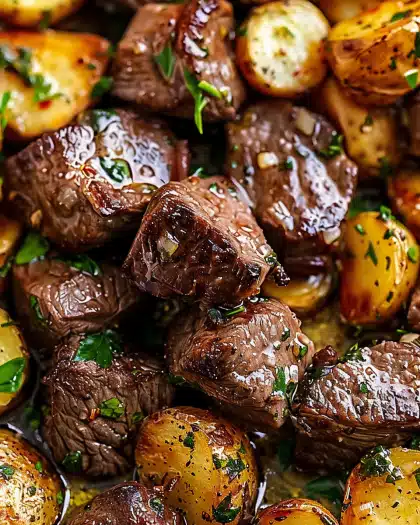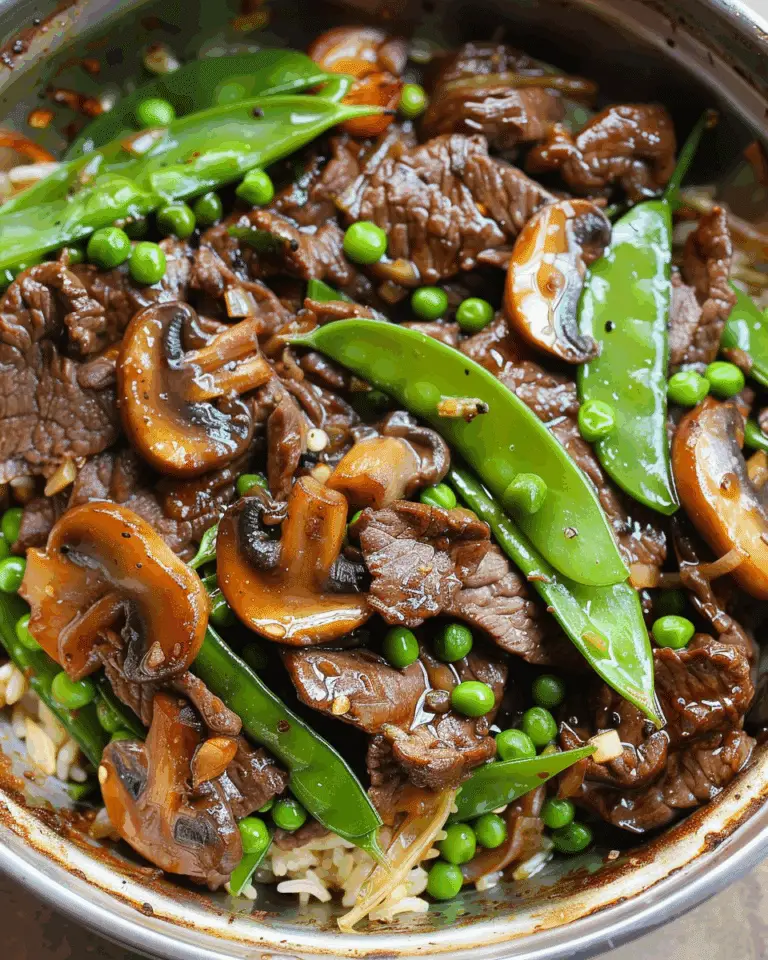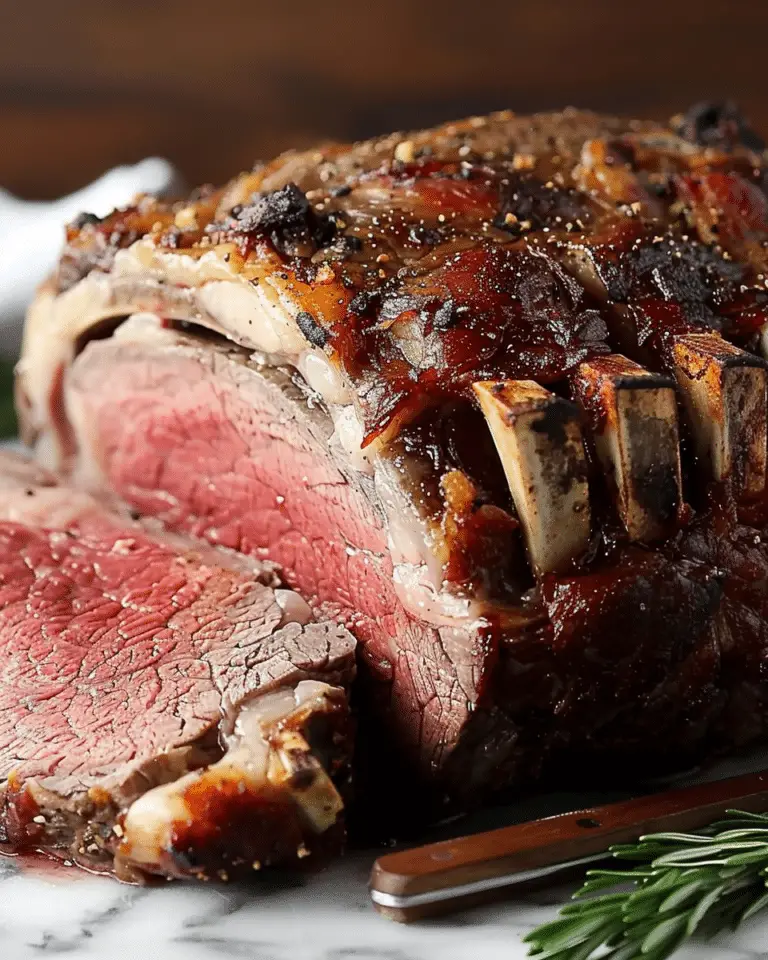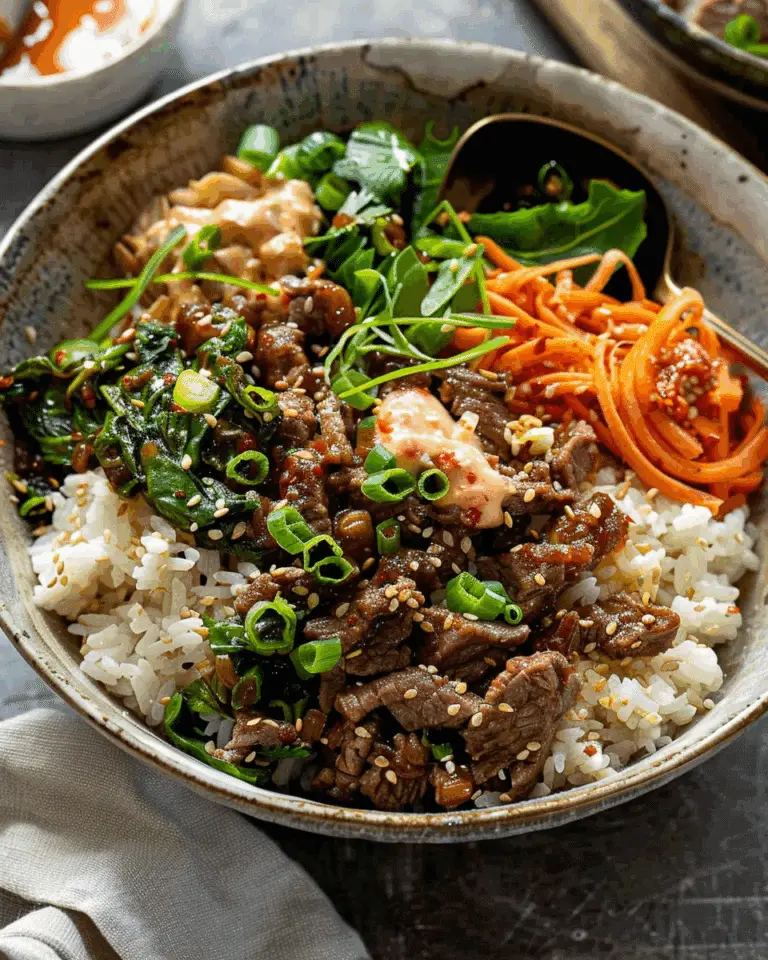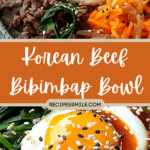Why You’ll Love This Recipe
I love this recipe because it’s bursting with flavor, texture, and color. Every bite has something a little different — from the savory beef to the crisp vegetables to the creamy egg yolk. It’s quick to make, great for meal prep, and easy to adapt to whatever I have in the fridge. Plus, it gives me that restaurant-style Korean flavor at home without much effort.
ingredients
(Here’s a tip: Check out the full list of ingredients and measurements in the recipe card below.)
For the beef:
-
Ground beef
-
Soy sauce
-
Brown sugar or honey
-
Garlic (minced)
-
Sesame oil
-
Ginger (grated, optional)
-
Black pepper
For the bowl:
-
Cooked white or brown rice
-
Carrot (julienned or shredded)
-
Zucchini (sliced or julienned)
-
Spinach or kale
-
Bean sprouts
-
Shiitake or button mushrooms (sliced)
-
Eggs (fried sunny side up)
-
Sesame seeds
-
Green onions (chopped)
-
Oil for sautéing
For the gochujang sauce:
-
Gochujang (Korean chili paste)
-
Sesame oil
-
Rice vinegar or lime juice
-
Honey or sugar
-
Water (to thin as needed)
directions
I start by cooking the rice so it’s ready and warm by the time everything else is done.
In a pan, I sauté the ground beef with garlic, sesame oil, soy sauce, sugar, and ginger. I cook it until browned and flavorful, then set it aside.
Next, I sauté the vegetables separately with a bit of oil and a pinch of salt — I cook the carrots, zucchini, spinach, mushrooms, and bean sprouts each for a few minutes until just tender but still bright and crisp.
I mix the gochujang sauce in a small bowl by stirring together gochujang, sesame oil, vinegar, honey, and a splash of water until smooth.
I fry the eggs sunny-side up, keeping the yolks soft for that perfect finishing touch.
To assemble, I scoop warm rice into a bowl, neatly arrange the cooked beef and veggies on top, add the fried egg in the center, and drizzle with gochujang sauce. I finish with sesame seeds and chopped green onions.
Servings and timing
This recipe makes about 4 bowls and takes around 35 minutes total — 10 minutes for prep and 25 minutes for cooking and assembling.
Variations
Sometimes I use tofu or sliced mushrooms instead of beef for a vegetarian version. I also mix in kimchi, cucumber slices, or shredded red cabbage for extra crunch and tang. For a low-carb version, I serve everything over cauliflower rice. If I’m short on gochujang, I make a quick sauce with sriracha, soy sauce, and a bit of sugar as a backup.
storage/reheating
I store leftovers in separate containers — rice, beef, veggies, and sauce — to keep everything fresh. It lasts up to 3 days in the fridge. I reheat the rice and beef in the microwave or skillet and quickly sauté the veggies again if needed. I always fry a fresh egg just before serving for the best texture.
FAQs
What is gochujang and where can I find it?
Gochujang is a Korean fermented chili paste with a spicy, slightly sweet flavor. I usually find it in the international aisle of major grocery stores or at Asian markets.
Can I make this dish ahead of time?
Yes, I prep all the components ahead and assemble the bowls fresh when I’m ready to eat. It’s great for meal prep.
Is bibimbap traditionally made with ground beef?
Traditionally, it’s made with sliced beef, but I use ground beef for convenience — it still delivers amazing flavor and texture.
Can I skip the egg?
Yes, but I find the runny yolk adds richness and ties everything together. A soft-boiled or poached egg also works beautifully.
What’s the best rice for bibimbap?
I usually use short-grain white rice for that classic sticky texture, but brown rice or jasmine rice works well too.
Conclusion
This Korean beef bibimbap bowl is a beautiful, balanced meal full of bold flavors, crisp vegetables, and comforting warmth. I love how easy it is to make at home and how customizable it is to my taste. Whether I’m serving it fresh or prepping it for the week, it’s a dish I come back to again and again.
Korean Beef Bibimbap Bowl
5 Stars 4 Stars 3 Stars 2 Stars 1 Star
No reviews
A flavorful Korean rice bowl topped with marinated beef, sautéed veggies, a fried egg, and spicy gochujang – bold, balanced, and satisfying.
- Author: Sarah
- Prep Time: 15 minutes
- Cook Time: 20 minutes
- Total Time: 35 minutes
- Yield: 2–3 servings
- Category: Main Course, Bowl
- Method: Sautéing, Frying
- Cuisine: Korean, Asian
- Diet: Gluten Free
Ingredients
For the Beef:
300 g (10 oz) ground beef
2 tbsp soy sauce
1 tbsp brown sugar or honey
1 tbsp sesame oil
2 garlic cloves, minced
1 tsp grated ginger
1 tsp gochujang (Korean chili paste, optional for heat)
Pepper, to taste
For the Bowl:
2 cups cooked white rice or brown rice
1 small zucchini, julienned
1 carrot, julienned
1 cup bean sprouts
1 cup baby spinach
4–5 shiitake or button mushrooms, sliced
1 tsp sesame oil (for veggies)
Salt, to taste
2 fried eggs
Toasted sesame seeds
Gochujang sauce (to serve)
Instructions
Prepare rice according to package instructions and keep warm.
Cook vegetables:
Sauté each vegetable separately in a bit of sesame oil with a pinch of salt (zucchini, carrot, mushrooms, spinach). Set aside.
Quickly blanch or sauté bean sprouts.
Cook the beef:
In a skillet, cook ground beef over medium heat until browned.
Add soy sauce, sugar, sesame oil, garlic, ginger, and gochujang. Simmer for 2–3 minutes.
Fry the eggs sunny-side up.
Assemble bowls:
Add rice to the bottom, arrange veggies and beef on top in sections.
Place fried egg in the center.
Garnish with sesame seeds and a spoonful of gochujang.
Notes
Customize with tofu or tempeh for a vegetarian version.
Add kimchi for extra flavor and fermentation benefits.
Make ahead by prepping veggies and meat in advance — great for meal prep!

